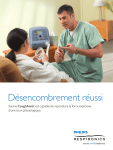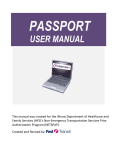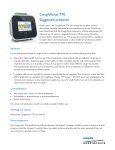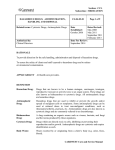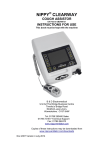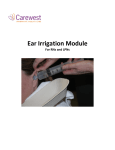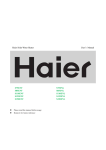Download LUNG VOLUME RECRUITMENT – MANUAL AND
Transcript
Section: CCL Subsection: Respiratory Care LUNG VOLUME RECRUITMENT – MANUAL AND MECHANICAL CS-04-03-13 Related terms: (Modified Manual Lung Volume Recruitment (MMLVR) and Mechanical Insufflation – Exsufflation (MI-E) Date Established: June 2012 Authorized by: Clinical Directors Date For Review: June 2015 Page 1 of 16 Dates Revised: RATIONALE To provide guidelines for the safe and effective use of Lung Volume Recruitment (LVR) including Modified Manual Lung Volume Recruitment (MMLVR) and Mechanical Insufflation – Exsufflation (MI-E). APPLICABILITY: RN, LPN, RRT, PT DEFINITIONS Assisted Cough Maneuver The application of a rapid abdominal thrust or lateral costal compression using various hand placements after an adequate spontaneous inspiration or maximal insufflation. Also known as a ‘quad cough’ (see Appendix ‘A2’ for procedure, indications, contraindications and complications). Glossopharyngeal Breathing (GPB) A method of breathing, which consists of a stroke like action of the tongue along with constricting action of the pharynx pumping air through the larynx into the lungs. Maximum Forced Expiratory Flow (MaxFEF) The maximum flow rate measure during a forced vital capacity (VC) maneuver. Maximum Insufflation Capacity (MIC) The maximum volume of air stacked within the client’s lungs beyond spontaneous vital capacity. MIC is obtained by having the take a deep breath, holding it and then breath stacking using a MMLVR bagging unit. Peak Cough Flow (PCF) The velocity of air expelled from the lungs after a cough CAREWEST Care and Service Manual Section: CCL Subsection: Respiratory Care LUNG VOLUME RECRUITMENT – MANUAL AND MECHANICAL CS 04-03-13 Page 2 of 16 maneuver as measured by a peak flow meter. A minimum PCF of 160 L/min is required for effective secretion removal. PCF can be measure using a simple peak flowmeter or calculated by multiplying the Forced Expiratory Flow (FEF) X 60. Vital Capacity (VC) The maximum amount of air that can be exhaled after a maximum inhalation. POLICY 1. MMLVR and MI-E will only be performed by designated staff who have undergone approved education and training. 2. A physician’s order is required to perform LVR (MMLVR and MI-E). 3. LVR (MMLVR and MI-E) cannot be performed through an endotracheal tube. 4. LVR (MMLVR) is used for the purpose of improving vital capacity (VC) and peak expiratory cough flow (PCF) in clients with impaired respiratory function. (Please see Appendix ‘A1’ for Indications and Contraindications of LVR MMLVR) 5. LVR (MI-E) is used for the purpose of assisting the removal of retained secretions in clients with impaired secretion clearance and ineffective cough, including but not limited to, spinal cord injury, neuromuscular disease and syringomyelia. (Please see Appendix ‘B’ for Indications and Contraindications of LVR MI-E). 6. LVR will only be performed on patients/clients who are alert, cooperative and able to communicate. 7. LVR is most effective when performed in conjunction with appropriate chest therapy. 8. When performed through a tracheostomy, LVR MI-E may lead to obstruction of tracheostomy tube. Caution should be exercised when performing LVR MI-E with an artificial airway. Post procedure assessment of tracheostomy tube patency is vital. 9. To avoid hyperventilation do not perform LVR procedures more frequently than every 10 minutes. 10. LVR can be performed in conjunction with an assisted cough maneuver (see Appendix ‘A2’). CAREWEST Care and Service Manual Section: CCL Subsection: Respiratory Care LUNG VOLUME RECRUITMENT – MANUAL AND MECHANICAL CS 04-03-13 Page 3 of 16 APPENDIX A - Lung Volume Recruitment (MMLVR) EQUIPMENT 1 - disposable Bagging Unit (reservoir removed and oxygen tubing removed) clearly labeled “Not for CPR”. 1 - set of nose clips (optional) 2 - one-way-valve connectors (remove leaf valve from device closest to client) 1 - connector 4 - pieces of 6-inch corrugated tubing 1 - mouthpiece, mask or tracheostomy 15mm adaptor PROCEDURE 1. Verify Physician’s order. (Note: the initial order will be directed to RRT and/or PT as an “LVR Manual and Mechanical Assess and Treat” order.) 2. Determine client eligibility for LVR (MMLVR) (see Appendix ‘A1’). 3. Assemble and test the equipment (see Appendix ‘A3’). 4. Explain the procedure to the client. 5. Establish with the client the signal they will use to indicate when MIC is reached or they wish to stop. 6. Ask the client to take a deep breath and hold it, apply the mask/mouthpiece and ask the client to continue to inhale. 7. 6.1 If using a mouthpiece, ask the client to place their lips tightly around the mouthpiece to prevent an air leak. You may need to use a nose clip initially until the client is proficient with MMLVR. 6.2 If using a mask, have the client hold the mask firmly on their face to prevent air leak. If client is unable to hold the mask on their face a caregiver will hold the mask on the face. 6.3 If performing MMLVR through a tracheostomy tube, ensure the client has a cuff-less tube or that the cuff is deflated. (Note: If the client tolerates corking, it is preferable to cork the patient and perform procedure through the upper airway.) Cue client to inhale again to stack breaths. Squeeze bag in synchrony with client’s inhalation. Client must not exhale between each breath. Continue to stack breaths CAREWEST Care and Service Manual Section: CCL Subsection: Respiratory Care LUNG VOLUME RECRUITMENT – MANUAL AND MECHANICAL CS 04-03-13 Page 4 of 16 three to five times as tolerated by client. (Note: The client may feel a stretch in the chest or slight discomfort when MIC is reached.) 8. Once the client’s lungs are full or the client signals MIC is reached, remove the mouthpiece, mask, or connector from the client and ask the client to continue holding their breath for 3 to 5 seconds and then slowly exhale. 8.1 9. If secretions are present, instead of slowly exhaling, ask the client to produce a strong cough/huff or include an assisted cough maneuver when indicated (See Appendix ‘A2’). Repeat steps 6 thru 8, three to five times. CAREWEST Care and Service Manual Section: CCL Subsection: Respiratory Care LUNG VOLUME RECRUITMENT – MANUAL AND MECHANICAL CS 04-03-13 Page 5 of 16 Appendix A1 - Indications and Contraindications for LVR MMLVR 1. Clinical Indications A client who is alert, cooperative and able to communicate and: a. has an established diagnosis of a neuromuscular or mechanical disorder that limits thoracic expansion, including but not limited to, spinal cord injuries, amyotrophic lateral sclerosis (ALS), muscular dystrophy, progressive multiple sclerosis (MS), Guillain-Barré syndrome (GBS), post polio syndrome, syringomyelia, and kyphoscoliosis. b. may be unable to mobilize and expectorate secretions, c. has a VC less than 70% predicted or anticipate a continued decline in VC. 2. Absolute Contraindications: a. hemoptysis, b. untreated or recent pneumothorax, bullous emphysema, severe COPD c. asthma, d. recent cardio-thoracic surgery, e. increased intracranial pressure (ICP), f. intracranial drains, g. nausea, h. impaired consciousness/inability to communicate. 3. Relative Contraindications: a. immediately following meals. b. rib fractures, c. hemodynamic instability, d. pregnancy, e. history of pneumothorax, f. presence of a large pleural effusion, g. client unable to breath stack. 4. Precautions: a. Clients known to have cardiac instability should be monitored for arrhythmias, SpO2, dyspnea, vital signs and symptoms b. Clients with long standing thoracic cage restriction who may have severely reduced thoracic compliance will require slow incremental insufflations during the initial MMLVR introductory period. CAREWEST Care and Service Manual Section: CCL Subsection: Respiratory Care LUNG VOLUME RECRUITMENT – MANUAL AND MECHANICAL CS 04-03-13 Page 6 of 16 Appendix A2 - Assisted Cough Maneuver Indication is to aid client with weak and/or paralyzed muscles to clear secretions. Assess strength of cough to decide on the amount of assistance and technique required for an effective cough. Contraindications to Lateral Costal (Technique 3) and Forearm Assisted Cough • osteoporosis ribs/spine • kyphoscoliosis • rib/thoracic pathology such as fractures, • bruising and metastasis Complications of Assisted Cough Maneuver • reduced coronary perfusion • regurgitation • incontinence • fatigue • rib or costochondral junction fracture Contraindications to Abdominal Assisted Cough • Pregnancy • Abdominal aortic aneurysm • Recent abdominal surgery • Acute upper gastrointestinal bleed • Paralytic Ileus • • • • • headache bronchospasm muscular damage or discomfort cough paroxysms chest pain • • • Hiatal Hernia Open Abdomen Abdominal anomaly Precaution to Abdominal Assisted Cough • IVC Filter • Insertion of new abdominal feeding tube (<48hours) Technique 1 Similar to the Heimlich Maneuver Client Position: Supine or sitting with Head of Bed (HOB) at desired angle. Assister Hand Position: Standing beside client (or straddling client) place heel of 1 hand over abdomen midline 2” below bottom of breast bone, place second hand on top and interlock fingers. Action: Client - takes deep breath and tries to cough. Assister – at beginning of cough pushes in and up evenly, firmly and quickly. CAREWEST Care and Service Manual Section: CCL Subsection: Respiratory Care LUNG VOLUME RECRUITMENT – MANUAL AND MECHANICAL CS 04-03-13 Page 7 of 16 Technique 2 Forearm and Hand Client Position: Supine or sitting with HOB at desired angle. Assister Hand Position: Standing beside client and place upper arm’s forearm across upper chest and lower hand over abdomen fingers facing client’s chin Action: Client - takes deep breath and tries to cough. Assister – at beginning of cough pushes down with forearm and in and up with lower hand evenly, firmly and quickly. Technique 3 Hands on lateral ribs Client Position: Supine or sitting with HOB at desired angle. Assister Hand Position: Standing beside client place hands on side of client’s lower rib cage. Action: Client - takes deep breath and tries to cough. Assister – at beginning of cough pushes hands down and in firmly and quickly. Appendix A3 - How to Obtain Modified Bagging Unit CAREWEST Care and Service Manual Section: CCL Subsection: Respiratory Care LUNG VOLUME RECRUITMENT – MANUAL AND MECHANICAL CS 04-03-13 Page 8 of 16 Appendix A4 - Cleaning/Assembly/Testing of Equipment used for MMLVR This procedure is completed on a weekly basis. Cleaning: 1. Mouthpiece/Mask/Corrugated Tubing, One-Way Valves and Nose Clips – Clean with warm soapy water, rinse well, and allow to air dry. 2. Bagging Unit – Clean exterior with damp cloth. Interior of bagging unit should remain clean as one-way valve isolates bagging unit from client. Testing of Equipment: The bagging unit should be tested prior to each use to ensure alignment of the 1-way valve and proper functioning of the unit. To test the unit: 1. Occlude client connector of bagging unit, squeeze bagging unit, resistance should be felt; no air should leak from bagging unit. 2. With client connector of bagging unit open, squeeze the bagging unit, the bagging unit should re-inflate quickly. Assembly: 1. Reassemble the unit by connecting the corrugated tubing to the client connector, place one way valves in-line and then connect mouth-piece (See picture in Appendix ‘A3’). CAREWEST Care and Service Manual Section: CCL Subsection: Respiratory Care LUNG VOLUME RECRUITMENT – MANUAL AND MECHANICAL Page 9 of 16 CS 04-03-13 Appendix A7 Community Modified Manual Lung Volume Recruitment Algorithm MD orders RT/PR MMLVR Assess and Treat Community RRT/PT consults MD VC = Vital Capacity LVR = Lung Volume Recruitment MI-E = Mechanical In/Exsufflator T/PT MMLVR Assess and Treat MD orders RRT/PT MMLVR Assess and Treat Any relative or absolute contraindications? YES NO Contact MD Measure VC if available and client is able MD overrides contraindications Spont. VC < 70%, or client unable to mobilize secretions or expected to decline? YES NO Continue current management. Notify MD, do not start MMLVR Trial of MMLVR YES Improved secretion mobilization improved cough strength? Client tolerating procedure? NO NO Do not continue MMLVR. Notify consulting physician Trial MMLVR with manual cough assist. Teach technique to family caregiver. Consider trial of MI-E if above procedure is ineffective. Arrange for continuing follow-up if required at discharge and obtain MD prescription. YES Continue MMLVR without manual cough assist. Teach technique to family caregiver. CAREWEST Care and Service Manual Section: CCL Subsection: Respiratory Care LUNG VOLUME RECRUITMENT – MANUAL AND MECHANICAL CS 04-03-13 Page 10 of 16 APPENDIX B Lung Volume Recruitment (MI-E) Points of Emphasis (MI-E) • LVR MI-E is best performed in the sitting or semi-recumbent position however, it can be done in the supine position if required. • Cervical spine stabilization must be assessed and the head and neck must always be supported if an assisted cough maneuver is performed in conjunction with exsufflation. • A jaw thrust may be required to maintain airway patency in clients with significant bulbar muscle weakness • LVR MI-E sessions are performed as per assessed need, to a maximum of every 10 minutes to avoid hyperventilation. • LVR MI-E is ideally done in the morning upon awakening, before meals and at bedtime. • Inspiratory and expiratory pressures of ± 20 to 30 cmH2O can be used to start. If the secretions are not being mobilized, increase the amount of expiratory pressure until they are cleared. Incremental changes of ±5 cmH2O can be tried. Minimum effective pressures are usually ±30 cmH2O with the most clinical effective pressures being ± 40 to a maximum of ±50 cmH2O. • Insufflation/exsufflation pressures are usually the same unless one wishes to minimize stretch to the intercostals muscles. • For clients previously using LVR MMLVR; treatments should continue on a daily basis, minimum twice a day. This ensures the client will be able to resume LVR MMLVR once the LVR MI-E is discontinued. • Clients requiring supplemental oxygen can be oxygenated between MI-E treatments. EQUIPMENT 1 - Mechanical Insufflator-Exsufflator 1 - 5- foot large bore disposable tubing 10 - 6-inch pieces of corrugated tubing with 15 mm connector for tracheostomy clients CAREWEST Care and Service Manual Section: CCL Subsection: Respiratory Care LUNG VOLUME RECRUITMENT – MANUAL AND MECHANICAL CS 04-03-13 Page 11 of 16 1 - bacteria filter 1 - transparent resuscitation mask or 1 - tracheostomy tube connector or 1 - mouthpiece and nose clip (used if client does not tolerate mask) 1 - suction source with Yankauer or tracheal suction catheter (consider use of in-line catheter) PROCEDURE 1. Verify Physician’s order. Note: the initial order will be directed to RT and/or PT as an “MI-E Assess and Treat” order. 1.1 Determine client’s eligibility for MI-E (see Appendix ‘B1’) 1.2 Explain the procedure to the client. 2. Set up equipment (see Appendix ‘B2’): 2.1 Attach Yankauer or suction catheter to suction 2.2 Attach the breathing circuit to the MI-E machine 2.3 If you have an automatic machine, place the machine on manual mode. 3. Ensure MI-E machine is cycling and returning to neutral (see Appendix ‘B3’). 4. Set the inhalation and exhalation pressures (see Appendix ‘B4’) 5. Start with the pressure to +/-20-30 cmH2O; this will familiarize the client with the feel of mechanical insufflation - exsufflation. 6. Adjust pressures as required to meet client needs and tolerance. Procedure performed with a mouthpiece or mask: 7. Verify pressure settings before starting each treatment. (Note: As this machine provides positive pressure, all the risks associated with positive pressure ventilation apply to this therapy.) 8. Attach the appropriate client interface to the breathing circuit. (Note: a full facemask is the preferred interface.) 9. Apply the interface to the client. 10. Instruct the client to inhale while shifting the manual control lever to the inhale position and hold for 2 to 3 seconds (count time out loud). 11. Rapidly shift the manual control lever to the exhale position to induce a cough, holding it there for 1 to 2 seconds. (Note: encourage the client to cough on exhalation phase. A manual assisted cough maneuver may be added where indicated at the onset of exhalation. Count time out loud.) 12. Repeat this inhale/exhale cycle 4 to 5 times as tolerated by the client. (Note: Allow the client to rest for 20 to 30 seconds after each cycle of 4 to 5 breaths.) 13. If the client coughs up secretions during any of the inhale/exhale cycles, remove the interface and clear the secretions before initiating any additional cycles. CAREWEST Care and Service Manual Section: CCL Subsection: Respiratory Care LUNG VOLUME RECRUITMENT – MANUAL AND MECHANICAL 14. 15. CS 04-03-13 Page 12 of 16 The entire procedure (4 to 5 inhale/exhale cycles) can be repeated 4 to 6 times during a treatment session. No oxygen is to be entrained into the MI-E machine; clients requiring high levels of oxygen may require pre-oxygenation or may require re-oxygenation between cycles. (Note oxygen can not be entrained into the circuit as this is a fire risk) Procedure performed through a Tracheostomy: 7. Assemble 10 – six inch pieces of corrugated tubing with 15 mm ID connectors 8. Attach flex tubing to machine and then to the client. 9. Perform the inhale/exhale cycles as with a mouthpiece or mask. 10. If flex tube fills with secretions, discard it and replace with new 6 inch flex tube/15 mm ID connector (may need to use higher pressures due to reduced diameter of the artificial airways). 11. A cuffed tube is preferred and should be inflated when performing the inexsufflation. The inexsufflator is connected directly to the tracheostomy tube. 12. In-exsufflation may be delivered on a client with a cuffless tracheostomy tube. Cork the tube and apply the in-exsufflation via a mouth piece or mask. The client must tolerate corking for the procedure and have excellent control of the upper airway. 13. Ensure to check the patency of the tracheostomy tube post procedure and restore cuff inflation to pre-treatment state (if applicable). CAREWEST Care and Service Manual Section: CCL Subsection: Respiratory Care LUNG VOLUME RECRUITMENT – MANUAL AND MECHANICAL CS 04-03-13 Page 13 of 16 Appendix B1 - Indications and Lung Volume Recruitment (MI-E) 1) Clinical Indications a) A client who is alert, cooperative and able to communicate and: i) has an established diagnosis of a neuromuscular or mechanical disorder that limits thoracic expansion, including but not limited to, spinal cord injuries, amyotrophic lateral sclerosis (ALS), muscular dystrophy, progressive multiple sclerosis (MS), Guillain-Barré syndrome (GBS), post polio syndrome, syringomyelia, and kyphoscoliosis. ii) may be unable to mobilize and expectorate secretions, iii) has a VC less than 70% predicted or anticipate a continued decline in VC. 2) Absolute Contraindications: a) hemoptysis, b) untreated or recent pneumothorax, bullous emphysema, severe COPD, c) asthma, d) recent cardio-thoracic surgery, e) increased intracranial pressure (ICP), f) intracranial drains, g) nausea, h) impaired consciousness/inability to communicate. 3) Relative Contraindications: a) immediately following meals, b) rib fractures, c) hemodynamic instability, d) pregnancy, e) history of pneumothorax, f) presence of a large pleural effusion, g) client unable to breath stack. 4) Precautions: a) Clients known to have cardiac instability should be monitored for arrhythmias, SpO2, dyspnea, vital signs and symptoms b) Patients/clients with long standing thoracic cage restriction who may have severely reduced thoracic compliance will require low incremental insufflations during the initial MI-E introductory period. CAREWEST Care and Service Manual Section: CCL Subsection: Respiratory Care LUNG VOLUME RECRUITMENT – MANUAL AND MECHANICAL CS 04-03-13 Page 14 of 16 APPENDIX B2 - Initial Set-Up for MI-E 1. 2. 3. Plug machine into electrical outlet Position the unit within easy reach of the client, or the operator of the unit. CAUTION: Position the device so that the air intake ports on the side and rear of the unit are not blocked. Assemble the client circuit (filter, large bore tubing and client interface) as follows: a. Attach the bacterial/viral filter to the client port on the front of panel. b. Attach the 5 foot 22mm ID large bore tubing to the bacterial/viral filter. c. Attach the appropriate client interface to the large bore tubing. CAREWEST Care and Service Manual Section: CCL Subsection: Respiratory Care LUNG VOLUME RECRUITMENT – MANUAL AND MECHANICAL CS 04-03-13 Page 15 of 16 APPENDIX B3 - Operational Verification 1. 2. 3. 4. 5. 6. Attach client circuit to the unit and block the end of the hose. Turn the power switch ON. Set the manual/auto switch to manual position (automatic models only). Set the pressure knob fully clockwise (maximum pressure). Cycle the manual control lever from inhale to exhale and observe the pressure gauge to ensure that positive and negative pressure is being applied to the patient circuit. Release the manual control lever from inhale position and observe that the pressure immediately drops to 0 cm H2O. Repeat for the exhale position. In either case, if the pressure does not drop to zero, the unit should not be used. APPENDIX B4 - Setting and Adjusting the Insufflation/Exsufflation Pressures 1. Turn on the power switch. 2. Set the air flow to full. 3. Attach the client circuit to the unit and block the end of the breathing circuit. 4. Set the manual/auto switch to manual (automatic models only). 5. Slide the manual control lever to the exhalation phase (to the left). Observe the pressure gauge on the unit and adjust the maximum pressure (negative) using the pressure knob to achieve the correct reading on the gauge. 6. Shift the manual control lever to the inhalation phase (slide to the right). Adjust the pressure reading by turning the inhale pressure knob to achieve the correct reading on the pressure gauge (clockwise to increase pressure and counterclockwise to decrease pressure). 7. Cycle the manual control lever from inhale (positive) to exhale (negative) and back a few times to ensure that the pressure and suction readings are correct. 8. Release the manual control lever to ensure that the pressure immediately returns to 0 cm H2O. If it does not, do not use the unit and send for maintenance. 9. Inspiratory and expiratory pressures of ± 20 to 30 cmH2O can be used to start. If the secretions are not being mobilized, increase the amount of expiratory pressure until they are cleared. Incremental changes of ±5 cmH2O can be tried. Minimum effective pressures are usually ±30 cmH2O with the most clinical effective pressures being ± 40 to a maximum of ±50 cmH2O. Insufflation/exsufflation pressures are usually the same unless one wishes to minimize stretch to the intercostals muscles. CAREWEST Care and Service Manual Section: CCL Subsection: Respiratory Care LUNG VOLUME RECRUITMENT – MANUAL AND MECHANICAL CS 04-03-13 Page 16 of 16 REFERENCES Calgary Health Region (May 2008). Lung Volume Recruitment – Manual and Mechanical. CLINC 103. Respiratory Services. CAREWEST Care and Service Manual

















